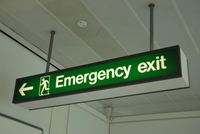During an emergency situation, companies need to ensure the safety of their staff by getting them out of the building. Here are six ideas to consider when developing an evacuation plan that will complement your overall disaster recovery plan:
- Chain of command. Emergency evacuations can be a chaotic time, which is why establishing a clear chain of command is important in maintaining order. Designate employees who are in charge of evacuating their team safely. They should also make sure that everyone is accounted for after the evacuation, so that they can coordinate with safety officials to recover anyone who is missing.
- Maps. The last thing you want to do during an evacuation situation is figure out where to go. Evacuation routes should be clearly defined with exit signs and mapped out ahead of time. If you have a large office space, map out several routes depending on what part of the office the employees are stationed, that way everyone can get out quickly, efficiently and safely. Maps should include the surrounding areas and have a clearly defined gathering point outside. Once completed, they should be posted around the office so that employees can access and review them.
- Lockdown. Certain areas of your office may need to be locked down in an emergency prior to evacuating. Designate two employees in this area to take charge of this: one as a primary and one as a backup in case the other isn't there. Once selected, review the lockdown procedure with them so that they can perform as fast as possible. Make sure to include a final check of the area to ensure that no one is left behind.
- Alarms. Warning and alarm systems should be installed throughout your facility. Make sure to include visual alarms so that hearing impaired employees will recognize the need to evacuate.
- Disabled employees. Make sure that disabled employees are accounted for. Develop plans specifically for them and designate employees as needed to assist them when evacuating.
- Test. Evacuation tests should be held annually. Give your employees advanced warning, but not specific times, such as informing them what week it will occur. That way no one will be concerned that there is an actual emergency when the test happens, but will be caught off guard enough to get an accurate representation of the evacuation plan.
There are so many factors to keep in mind when disaster planning that it can help to have an extra pair of hands working on the problems. Investing in business continuity consultants is the best way to bring experts in to ensure your strategies are up to par.

